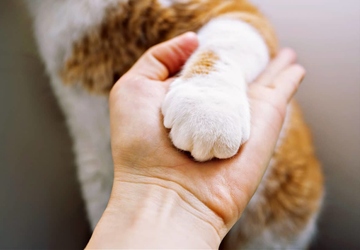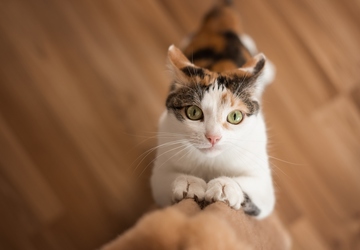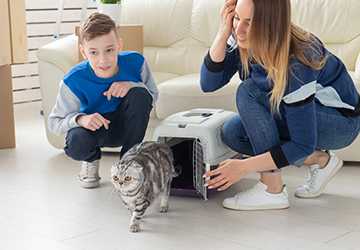Declawing or onychotomy is a surgical procedure to remove a cat's claws. It is often misunderstood and thought to simply remove the claws, similar to clipping a human's nails. However, when you consider that the terminal phalanx of each toe is amputated during the procedure, it becomes clear why you shouldn't declaw your cat. This is equivalent to amputating a human finger at the distal interphalangeal joint. The dangers of declawing a cat are varied and prevalent, affecting their physical health, behaviour, and overall well-being.
Physical Consequences of Declawing

One of the main dangers of declawing a cat is direct physical trauma. The surgery can cause extreme pain, bleeding, and sepsis. In addition, some cats experience complications such as lameness, back pain, and regrowth of improperly removed claws, which can be very painful.
Ongoing Pain and Long-Term Sequelae
Cats that have been declawed often suffer from chronic inflammation of the claws. This is because removing the terminal phalanx of the toes changes how they move and stresses the joints and spine. The changes in gait that can lead to osteoarthritis and ongoing mobility issues further highlight the reasons not to declaw cats.
Damage to Natural Defense Mechanisms
Removing claws fundamentally disrupts a cat's built-in defence mechanisms. Cats use their claws for many important activities, including climbing, hunting, and self-protection. The inability to perform these actions can trigger a persistent state of vulnerability, highlighting the reasons not to declaw cats.
Effects on Social Interactions
The dangers of declawing cats permeate their social dynamics. Cats find it difficult to establish and maintain their hierarchical position among their companions without claws. The disorder can increase stress and aggression, another reason not to declaw cats.
Evolutionary Disadvantages
Declawing has an evolutionary disadvantage. The process deprives cats of important survival mechanisms, making them unable to adapt effectively to their environment. The dangers of declawing cats are immediate and long-term, affecting their ability to adapt and thrive.
Behavioural Changes
Behavioural abnormalities are another important consideration when considering why you should not declaw your cat. Cats rely on their claws for a variety of instinctive behaviours, such as B. Scratching, to define their territory, stretch their muscles, and relieve stress. Cats can become more aggressive or resort to biting as a defence mechanism without claws. The dangers of declawing cats include increased aggression and a greater susceptibility to neurasthenia and depression.
Psychological Consequences
The psychological harm of declawing cats is serious. Unable to perform instinctive activities, declawing cats may experience increased stress and anger. This can lead to behavioural problems, such as urinating outside the litter box and defecating inappropriately. Understanding why cats should not be declawed highlights the importance of protecting cats' natural behaviours and ensuring their psychological health.
Long-term Health Consequences
Neurological Effects
Declawing can lead to neurological complications due to iatrogenic nerve damage during the procedure. These consequences further illustrate the dangers of declawing cats and highlight why cats should not be declawed from a neurophysiological perspective.
Increased Likelihood of Joint Disease
Cats that have had their claws removed are susceptible to joint disease. The dangers of cat declawing are highlighted by the abnormal gait caused by declawing, which puts disproportionate stress on their joints and can lead to chronic conditions such as osteoarthritis.
Alternatives to declawing

Many alternatives to cat declawing effectively control unwanted scratching behaviour without harming your cat.
Daily Nail Trimming
Trimming your cat's claws regularly can reduce the damage caused by scratching. This simple and non-invasive method can be integral to your cat's declawing alternatives.
Provide Scratching Posts and Pads
Purchasing scratching posts and pads can provide cats with appropriate scratching opportunities. These items come in various materials and styles, encouraging cats to scratch on them instead of furniture. This is one of the most effective alternatives to cat declawing because it redirects behaviour without harming your cat's health.
Application of Soft Paws
Soft paws are vinyl nail covers that stick to your cat's paws. They prevent damage from scratching while allowing your cat to naturally extend and retract their claws. Soft Paws are a humane and effective alternative to cat declawing.
Behavior Conditioning
Training your cat to scratch posts and rewarding positive behaviours can also be a helpful alternative to clawing. Positive reinforcement encourages cats to use their claws appropriately.
Environmental Enrichment
Creating an enriched environment is a very effective alternative to pulling. Incorporating interactive toys, climbing devices, and scratching posts can distract a cat from harmful scratching tendencies.
Using Repellent Sprays
Deterrent sprays that contain pungent odors that are repugnant to cats can be sprayed on furniture and other areas where they do not want to be scratched by cats. This approach can serve as a practical alternative to clawing by preventing destructive behaviours without causing harm.
Physical Barriers
Physical barriers such as double-sided tape or protective covers on furniture can discourage cats from scratching inappropriately. These barriers can serve as a direct alternative to declawing a cat. They protect household items while preserving a cat's natural tendencies.
Veterinarians' Views on Declawing
Many veterinarians strongly oppose declawing cats because of the many dangers associated with it. Due to its inhumane nature, the procedure has been banned or restricted in several countries and U.S. cities. Veterinarians promote alternative measures to declawing cats because they are safer and more ethical.
Ethical considerations and legal measures
Global Campaign for A Ban
Recognizing the dangers of declawing cats, many countries and communities have enacted bans or strict regulations against declawing cats. These legal actions reflect a growing ethical consensus and highlight why cats should not be declawed.
Ethical Veterinary Practice
Ethical veterinarians advocate for alternatives to cat declawing and balance their approach with humane treatment paradigms. They provide comprehensive guidance to pet owners on managing clawing behaviours without removing the claws.
Animal Welfare Organizations' Position
Major animal welfare organizations, such as PETA, strongly oppose declawing cats. They explain why cats should not be declawed and advocate for alternatives that ensure the well-being and humane treatment of cats.
Conclusion
The evidence against cat declawing is irrefutable and shows why cats should not be declawed. The dangers of declawing cats extend beyond the immediate physical pain to include chronic pain, behavioural changes, and psychological distress. By exploring alternatives to cat declawing, cat owners can ensure their pets remain healthy and happy and do not suffer unnecessary pain.














